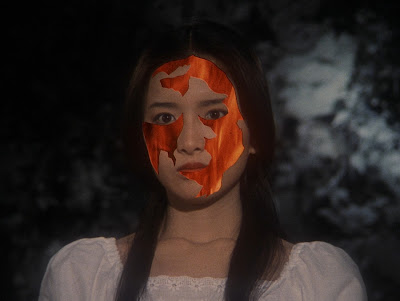
On the knuckles of one hand is the word LOVE, on the other, HATE, and let’s just say the former’s there mostly for show. Preacher Harry Powell (Robert Mitchum), a charismatic psychopath, likes to employ these stark tattoos to recount an inane little religious parable about the war between our better and lesser selves, the whole thing wrapping up in a triumphant wrestling hold and a slack facial expression that presumes his listeners rapture. There’s a scene where a boy tells his sister a bedtime story, and another where an old woman narrates the discovery of the baby Moses for a gaggle of children. People sing each other songs and tell each other tales throughout The Night of the Hunter (1955), which is itself balanced on the frontier of rural noir and horrific fairy tale, though we might well just call it Southern Gothic. The only movie ever directed by the great actor Charles Laughton and one of only two ever written by the great critic James Agee, this resides in its own category, a peculiar, and tremendously beautiful work that has a nagging tendency to stick in the minds of all who see it. It’s available now on DVD and Blu-ray from the Criterion Collection.

John (Billy Chaplin) and Pearl (Sally Jane Bruce) watch as the cops come for Ben (Peter Graves), their father, soon after sentenced to death for robbery and murder. Ben spends his last days sharing a cell with Harry Powell, and after Ben’s execution Harry’s left haunted by the question as to where Ben hid the stolen cash. Upon release, Harry finds, weds, and ultimately disposes of Ben’s all-too naïve widow Willa, played, with a little too much theatre, by Shelley Winters, in a role that very much anticipates her unlucky widow in Lolita (62). “My body’s just a-quivering with cleanliness,” she exclaims at one point. She longs for new baptism and in some macabre sense finds it at the bottom of the same river where Ben was said to have installed his treasure. The image of Willa below the water’s surface, seated behind the wheel of a Model T, her hair flowing behind her in chorus with the weeds, a spectral tableau of death photographed by Stanley Cortez.

That image is more haunting for the absence of underscoring, its near-silence finally broken only by Harry singing ‘Leaning on the Everlasting Arms’ unaccompanied, the same song he’ll later sing in a wonderfully unlikely duet with Lillian Gish’s tough, shotgun-wielding foster mother and fierce child protectress while he encircles her house in the dead of night. The resistance to over-cook such moments with obviously portentous music or framing is emblematic of Night of the Hunter’s exquisite elegance. There’s a scene where Pearl makes paper dolls with some of the secreted bills and a handful of them are blown by a night breeze right past Harry’s feet without his noticing. Laughton knew when he’d cast his spell. You’ll say it’s a shame that Laughton never directed again, yet when someone does it so perfectly once perhaps that’s enough.

Mitchum, usually the essence of cool anyway, likewise never winks at us, largely keeping his focus singular and Satanic, only to suddenly transform into an animalistic fiend, almost cartoon-like, in two key moments. His Harry is a very American sort of false Messiah, a chastising, sexually repressed misogynist convinced he holds private conference with God, with whom he’s worked out his own personal moral order. This arrangement grants him complete license in pursuit of his goal, and so he follows those kids relentlessly as they make their way slowly down-river on a skiff, overlooked by turtle, owl, toad, fox, sheep and rabbits, storybook emissaries. Harry’s in no hurry. I’m not even sure he really wants the money. He’s convinced of his right to some strange and bloody destiny and follows it without pause for remorse, ambling along by horse or by car, taking what he needs, exterminating whatever blocks his path on his way to glory—and right into the highest niches of cinema history.















































